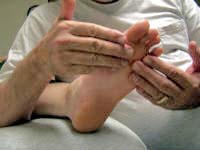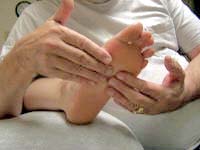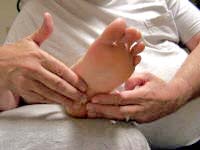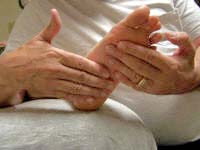 Winning Hands Massage
Winning Hands Massage
Plantar Fascitis
A very common, very painful, condition is plantar fascitis. This is a
bunching up of the plantar fascia on the sole of the foot, resulting in
cramping. It typically is most prevalent first thing in the morning. The
following photos illustrate the hand positions for performing myofascial
release treat the problem. The first and most important position is at the
ball of the foot. Apply ONLY enough pressure to engage the tissue into a
stretch towards the sides of the foot. As the fascia releases, it will feel
like a quivering under the skin and the fingers will start to slide apart.
Repeat in the middle and at the heel. Final position is in the arch, but the
direction of stretch is toward the toes and heel.
Here is some additional information on Plantar Fascitis. It is an excerpt
from pages 123-124 of “A Massage Therapist’s Guide to Pathology” by Ruth
Werner. It is an excellent reference book, by the way, and one I would
recommend hands-down to anyone.
At any rate:
“Plantar Fascitis
Definition: What Is It?
This is a condition involving pain and inflammation of the plantar fascia,
which stretches from the calcaneus to the metatarsals on the plantar surface
of the foot.
Demographics: Who Gets It?
This is a common problem; 95 % of all heel pain is diagnosed as plantar
fascitis. Up to 2 million cases are reported per year, and that includes
only people who seek treatment. …
Etiology: What Happens?
When the plantar fascia is overused or stressed by misalignment, its fibers
tend to fray. This is essentially the same as a tendon or ligament tear.
Radiographs very frequently show that a bone spur has developed at the
attachment to the calcaneus. It was once assumed that these bone spurs
caused the pain of plantar fascitis. It is now clear that the chronic
irritation of injured fascia stimulates the growth of the bone spurs, not
that bone spurs cause fascial irritation.
The pain that accompanies plantar fascitis occurs when the foot has been
immobile for several hours and is then used. The fibers of the fascia begin
to knit together during rest and are re-torn each time the foot goes into
even gentle weight-bearing dorsi-flexion.
Signs and Symptoms
Plantar fascitis follows a distinctive pattern that makes it easy to
identify; it is acutely painful for the first few steps every morning. Then
the pain subsides or disappears altogether, but becomes a problem again with
prolonged standing, walking or running. A sharp “bruised” feeling either
just anterior to the calcaneus on the plantar surface or deep in the arch of
the foot often marks this disorder.”
I won’t bother including her treatment recommendations because I have found
the myofascial release technique I described earlier to be incredibly
effective and something that anyone can easily do for themselves.
Home Page |
Mike's Biography and Training |
Treatment Information |
Mike's Recommendations |
Mike's Writing
(c) 2005-2007 Mike Uggen,
Phone: (317) 297-7263
Cell: (317) 508-8556
WA License Number 16912
Web Design by Barbara Uggen-Davis
 Winning Hands Massage
Winning Hands Massage Winning Hands Massage
Winning Hands Massage


